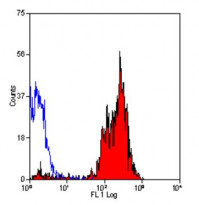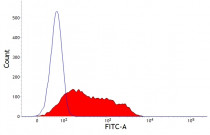ARG23913
anti-CD46 antibody [6D8/8]
anti-CD46 antibody [6D8/8] for Flow cytometry,Immunoprecipitation,Western blot and Pig
Overview
| Product Description | Mouse Monoclonal antibody [6D8/8] recognizes CD46 |
|---|---|
| Tested Reactivity | Pig |
| Tested Application | FACS, IP, WB |
| Host | Mouse |
| Clonality | Monoclonal |
| Clone | 6D8/8 |
| Isotype | IgG1 |
| Target Name | CD46 |
| Antigen Species | Pig |
| Immunogen | Porcine peripheral blood mononuclear cells. |
| Conjugation | Un-conjugated |
| Alternate Names | MIC10; TLX; CD antigen CD46; Trophoblast leukocyte common antigen; AHUS2; TRA2.10; Membrane cofactor protein; MCP |
Application Instructions
| Application Suggestion |
|
||||||||
|---|---|---|---|---|---|---|---|---|---|
| Application Note | FACS: Use 10 µl of the suggested working dilution to 10^6 cells in 100 µl. * The dilutions indicate recommended starting dilutions and the optimal dilutions or concentrations should be determined by the scientist. |
||||||||
| Observed Size | 40 kDa |
Properties
| Form | Liquid |
|---|---|
| Purification | Purification with Protein G. |
| Buffer | PBS and 0.09% Sodium azide. |
| Preservative | 0.09% Sodium azide |
| Concentration | 1 mg/ml |
| Storage Instruction | For continuous use, store undiluted antibody at 2-8°C for up to a week. For long-term storage, aliquot and store at -20°C or below. Storage in frost free freezers is not recommended. Avoid repeated freeze/thaw cycles. Suggest spin the vial prior to opening. The antibody solution should be gently mixed before use. |
| Note | For laboratory research only, not for drug, diagnostic or other use. |
Bioinformation
| Database Links | |
|---|---|
| Gene Symbol | CD46 |
| Gene Full Name | CD46 molecule, complement regulatory protein |
| Background | The protein encoded by this gene is a type I membrane protein and is a regulatory part of the complement system. The encoded protein has cofactor activity for inactivation of complement components C3b and C4b by serum factor I, which protects the host cell from damage by complement. In addition, the encoded protein can act as a receptor for the Edmonston strain of measles virus, human herpesvirus-6, and type IV pili of pathogenic Neisseria. Finally, the protein encoded by this gene may be involved in the fusion of the spermatozoa with the oocyte during fertilization. Mutations at this locus have been associated with susceptibility to hemolytic uremic syndrome. Alternatively spliced transcript variants encoding different isoforms have been described. [provided by RefSeq, Jun 2010] |
| Function | Acts as a cofactor for complement factor I, a serine protease which protects autologous cells against complement-mediated injury by cleaving C3b and C4b deposited on host tissue. May be involved in the fusion of the spermatozoa with the oocyte during fertilization. Also acts as a costimulatory factor for T-cells which induces the differentiation of CD4+ into T-regulatory 1 cells. T-regulatory 1 cells suppress immune responses by secreting interleukin-10, and therefore are thought to prevent autoimmunity. A number of viral and bacterial pathogens seem to exploit this property and directly induce an immunosuppressive phenotype in T-cells by binding to CD46. [UniProt] |
| Cellular Localization | Cytoplasmic vesicle, secretory vesicle, acrosome inner membrane; Single-pass type I membrane protein. Note=Inner acrosomal membrane of spermatozoa. Internalized upon binding of Measles virus, Herpesvirus 6 or Neisseria gonorrhoeae, which results in an increased susceptibility of infected cells to complement-mediated injury. In cancer cells or cells infected by Neisseria, shedding leads to a soluble peptide. [UniProt] |
| Calculated MW | 44 kDa |
| PTM | N-glycosylated on Asn-83; Asn-114 and Asn-273 in most tissues, but probably less N-glycosylated in testis. N-glycosylation on Asn-114 and Asn-273 is required for cytoprotective function. N-glycosylation on Asn-114 is required for Measles virus binding. N-glycosylation on Asn-273 is required for Neisseria binding. N-glycosylation is not required for human adenovirus binding. Extensively O-glycosylated in the Ser/Thr-rich domain. O-glycosylation is required for Neisseria binding but not for Measles virus or human adenovirus binding. In epithelial cells, isoforms B/D/F/H/J/L/3 are phosphorylated by YES1 in response to infection by Neisseria gonorrhoeae; which promotes infectivity. In T-cells, these isoforms may be phosphorylated by LCK. [UniProt] |
Images (2) Click the Picture to Zoom In
-
ARG23913 anti-CD46 antibody [6D8/8] FACS image
Flow Cytometry: Porcine peripheral blood granulocytes stained with ARG23913 anti-CD46 antibody [6D8/8].
-
ARG23913 anti-CD46 antibody [6D8/8] FACS image
Flow Cytometry: Porcine peripheral blood lymphocytes stained with ARG23913 anti-CD46 antibody [6D8/8] followed by Goat anti-Mouse IgG (H+L) antibody (FITC).







